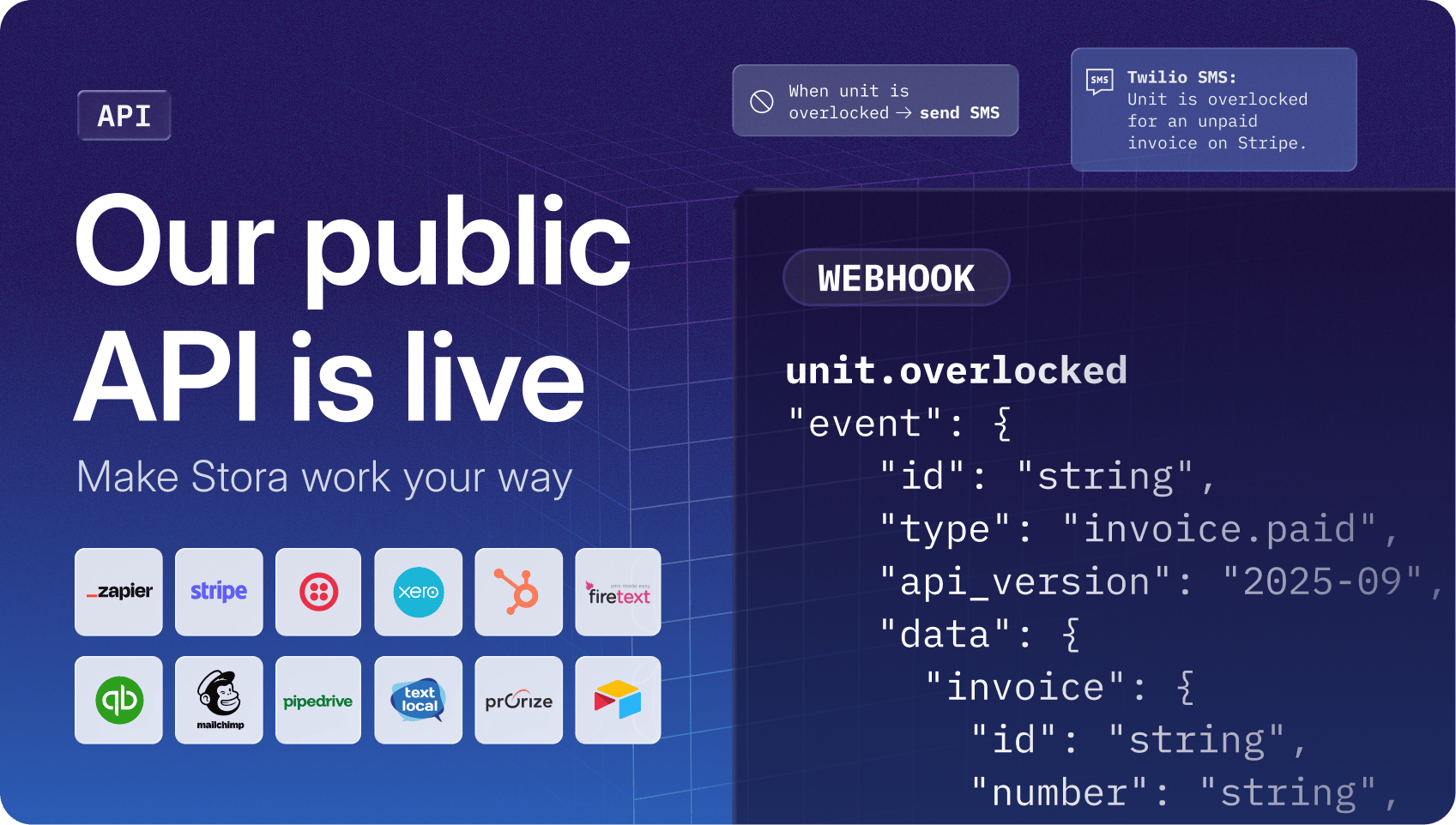Starting a new business in an unfamiliar sector can be daunting. But you’re not alone; most new self storage facilities are started by folks who are new to the industry.
You’ve probably had a successful career in another sector, heard tales of the generous returns self storage generates for investors, and now you're ready to start your adventure.
We’ve been there, and we’re here to help. This article explains how to start a self storage business in eight steps.
But first, let’s take a deeper look at why starting a self storage business is such a good idea.
Why Self Storage Is a Compelling Business Model
Self storage has proven to be one of the most resilient sectors in commercial real estate.
Even during periods of economic uncertainty, storage business owners continue to see stable demand and strong returns.
Here are some of the reasons why.
Consistent demand, even in tough markets
In both the U.S. and the U.K., storage demand has remained steady despite inflation and changing consumer habits.
When people move, downsize, or run a small business from home, they need somewhere to store their belongings. The result is a business model that performs well in almost any economic climate.
According to the 2025 Self Storage Association U.K. Annual Report, the sector generated more than £1.2 billion in turnover, with total floor space rising by 7.2% to 64.3 million sq ft.
Average rental rates also increased to £29.13 per sq ft per year, showing that operators are still able to raise prices while maintaining strong occupancy levels of around 75%.
Long-term opportunity in the U.K. and Europe
Compared with the U.S., the U.K. and Europe remain significantly undersupplied.
The U.K. currently offers about 0.94 sq ft of storage space per person, while the U.S. has roughly 7.5 sq ft per person. That gap represents enormous room for expansion across the continent.
In mainland Europe, self storage space continues to grow steadily at around 10% year-on-year, with rental rates rising by 5.4% on average.
Despite this growth, countries like Spain and Germany still have far lower penetration than the U.K., meaning the self storage market is far from saturated.
A business built for today’s lifestyles
Changing work and lifestyle patterns are also driving long-term demand. Remote work has led many companies to downsize their offices and store equipment off-site.
E-commerce businesses increasingly use self storage units as flexible stockrooms. At the same time, rising property prices and smaller living spaces have made storage a necessity for households across cities.
Recession-resilient, recurring revenue
Unlike many property sectors, self storage income tends to be recurring and spread across hundreds of tenants rather than a handful of large leases.
That makes it less vulnerable to single-tenant defaults or market downturns. During economic slowdowns, new customer groups such as people relocating or consolidating businesses often replace any lost revenue.
Together, these factors make self storage one of the most compelling business opportunities for new investors today.
With the right location, operating model, and software platform, it offers predictable income, scalable growth, and long-term stability.
The following section explains how you can take advantage of these opportunities and start your own self storage business.
8 Steps to Start Your Self Storage Facility
Now that you understand why self storage is such a strong investment opportunity, let’s walk through the eight essential steps to start your own facility, from researching your market to setting up the right systems for long-term success.
1. Conduct market research
Before investing in a facility, take time to understand your market. Feasibility research helps you choose the right location, forecast how quickly you’ll reach profitability, and avoid losing money.
There are four main factors to consider:
Define your trade area
Start by mapping a clear catchment zone, usually 3 to 5 miles in cities or up to 10 miles in suburban or rural areas. You can use a map like this to work out your search radius.

Consider how far you are willing to travel and how often you plan to be on the premises. Some locations may be difficult to get to due to heavy traffic. This would not only take up your time but would also be inconvenient for customers.
Researching populations
To decide which locations are viable contenders, list out the towns or cities within your commute area in a table or spreadsheet and work out their populations.
This can take a bit of time depending on how many places are on your list and where in the world you’re researching, but here are few links to help you:
US Census Bureau: Scroll to the ‘Incorporated Places’ section and click on your state. An Excel file will download listing every town’s/city’s population as of 2020 and a 2021 projection.
Statistics Canada: Scroll midway down the page to use their city/zip code search box.
United Kingdom: Getting population details on all UK towns and cities still isn’t easy online, but you can use the Scotland Census Area Overview (2011 stats), and try this Area Explorer for Northern Ireland data. In addition, non-government sites like citypopulation.de aggregate publicly available population data worldwide, and you can search English or Welsh town names to view 2020 population estimates.
Ireland’s Central Statistics Office: Download this spreadsheet of the 2016 census’ total populations for 874 towns in Ireland.
Australian Bureau of Statistics: Enter your town name in the ‘Search by Area’ field. A search results section will appear a little further down the page. Click its ‘All Persons’ button to quick-view the ‘People’ stats for that location.
Look at population growth, household income, and housing density to gauge long-term demand.
Identify who your customers are likely to be: homeowners who’ve run out of space, students, or local businesses needing stock storage.
Finding unmet demand
With your population table complete, the next step in choosing your location is to determine which area offers the best business potential.
Start by using your country’s average square footage per person. Most self storage associations have this figure available on their websites.

In the US, it’s 7.5 sq ft per person, so you’d multiply the population of each town by this to determine how much self storage the area can support. So a town of 20,000 people could support 150,000 sq.ft. of rental storage space.
The next question: How much self storage space is already on offer in each location on your list?
Go online, find out approximately how much space your competitors have built in each town/city and add this to your spreadsheet.
Then subtract the two values for each town to see how much space is up for grabs in each area. The more space for the taking, the better your returns should be.

If you want to get even more precise about potential vs competitor capacity, go back to your radius map and plot 3 or 5-mile radius circles around each competitor’s address.

Most customers won’t drive more than 5 miles from their home for self storage, and this could help you visualise any lucrative unclaimed locations between your competitors’ catchments.
It’s worth noting that the current supply of self storage per head isn’t necessarily the same as the current demand.
There’s likely to be significant unmet demand in most markets. The biggest opportunities are often found in smaller towns.
They can present a number of benefits including:
Less-expensive commercial properties than cities.
Lower property taxes.
Less or no competition for business.
Faster word-of-mouth promotion.
Nobody to outbid in online advertising.
Nobody to get into a price war with.
Audit competitors and pricing
At this time, it’s also worth doing a quick competitive analysis. List every facility within your target area and note their occupancy rates, pricing, and available unit sizes.
Check online reviews to see what customers like or dislike about them. This will reveal both market gaps and service opportunities.
Gavin Shields, Stora’s founder, used this same approach when he built his first automated facility.
He spent weeks benchmarking nearby operators, visiting sites, and comparing rate cards before identifying an underserved area with strong business demand. That research later helped him reach stable occupancy faster than expected.
Check zoning, planning, and access
Once you have a shortlist of potential sites, confirm that local regulations allow self storage use.
You’ll need to check planning permissions, access routes, signage restrictions, and whether the site has utilities for lighting, climate-controlled units, or security systems.
Model your costs and breakeven point
Use the data you’ve gathered to test different financial scenarios. Estimate build or acquisition costs, operating expenses, and achievable rent per square foot.
Then calculate the occupancy rate you’ll need to break even. This should typically be between 65 and 75 percent.
2. Choose to build, buy or use modular containers
There are broadly three main ways into the self storage industry: build your own facility, buy an existing one or create a facility using modular containers.
Below, we look at the pros and cons of each.
Build a new facility from scratch
This is when you construct a purpose-built facility from the ground up, tailored to your ideal layout, customers, and technology.
✔️ Pros:
Full control over the size of self storage units and layout of the facility.
Potential for the highest long-term returns.
Easier to integrate smart entry and digital systems from day one.
Cons:
High upfront cost and longer construction timelines.
Planning permissions and financing can be complex.
Revenue delay until the build is complete and operational.
Buy an existing self storage facility
This involves purchasing an operational storage site and improving or rebranding it.
✔️ Pros:
Immediate cash flow from existing facility tenants.
Lower development risk.
Opportunity to add value through upgrades and software automation.
❌ Cons:
May inherit outdated systems or deferred maintenance.
Less flexibility in layout and design.
The upfront price can be inflated if the site is performing well.
Start with modular containers
This is when you use portable shipping containers to create a low-cost, scalable storage site. It’s also possible to buy an operational modular shipping container business.
✔️ Pros:
Fastest and most affordable way to start.
Flexible setup, can expand or relocate easily.
Often requires fewer planning approvals.
❌ Cons:
Lower rental rates per unit.
Limited climate control and branding potential.
May face restrictions on land use or long-term leasing.
How much each one costs will obviously vary; however, as a rule of thumb:
A container storage facility costs $61,000–$122,000.
Hiring and retrofitting a warehouse costs $122,000–$756,500.
Building your own facility requires at least $756,000.
Read our article on how much it costs to build 100 storage units to find out more.
The three options mentioned above aren’t the only factors that impact costs.
Others include:
Military storage.
Business storage.
24-hour storage.
Investment inflators
There are a few variables worth mentioning that will push up your initial investment:
Buying instead of leasing: Purchasing land or a warehouse will cost you more upfront than leasing will.
Extent of construction and repairs: The more work needed, the more money you’ll need. For example, outdoor sites may require you to tarmac the parking area and install a high-quality fence and gate for security. Indoor sites might require a mezzanine floor or a new roof.

To help you fine-tune your numbers, try our free self storage financial modeller to work out the initial and maximum funding you’ll need for your storage unit business in years one through four.
3. Find your premises
When it comes to visibility, footfall, demand, ease of access, your property location matters. So when you’ve narrowed down your location(s), start shopping for premises:
Check major real estate websites for available listings.
Visit nearby towns or cities to identify promising areas.
Pay attention to where the outdoor advertising billboards are located.
Meet with realtors and let them know what you’re looking for.
It’s impossible to get the perfect site, but look out for (and perhaps score each site against) benefits such as:
Lots of passing traffic with a building visible from the road.
Lots of nearby houses and businesses.
Ideally new home building going on nearby.
Not too much competition in the area.
The ability to rent or buy land or a warehouse at prices that work.
Finding all of the above is almost impossible, so simply try your best to get a good combination of each, but don’t rule a site out if it’s missing one or more because it could still work.
This stage can be exciting, but it’s also where many people give up. That’s because finding suitable sites isn’t easy. It takes time, hard work, and luck!
4. Select an operational model
Next, you need to decide how you’ll operate. For example, will you be:
A traditional staffed facility?
Or automated and remotely managed?
A traditional facility has recognizable staff on hand at all times to help customers. Some tenants find this reassuring. However, it can also be expensive to run, as you’ll have to pay wages.
An automated, remote facility allows customers to manage their unit using digital technologies. They book online, use their mobile devices to access their unit, and payments are taken automatically.
💡 Our recommendation: Even if you think having staff onsite is essential, using automation software and modern technologies significantly improves the customer experience. We therefore recommend you implement some sort of self storage software.
5. Choose your products
Next, you need to choose the systems that will allow you to operate your facility. Examples include:
Access control and locks.
HVAC.
Communication.
Security.
Management software.
Payment processing.
Network equipment.
Office furniture and supplies.
You’ll also need to source boxes and other supplies for customers.
It’s worth doing some research to ensure that you get the right products for your business.
For example, when Gavin set up his facility, he was keen to make it fully automated. This led him to choose nokē doors from Janus, as they could be opened using a mobile app.

6. Decide on your investment amount and financing options
Once you’ve validated demand in your target area and chosen the type of storage you’ll provide, the next step is to understand how much capital you’ll need and how you’ll fund it.
Getting this right early helps you avoid cash flow surprises later and ensures your facility can reach profitability without unnecessary strain.
Begin by estimating your startup costs. Your total investment will depend on your chosen model: whether you’re building a new facility, converting an existing property, or starting with portable container units. Each path carries its own cost profile.
Typical startup expenses include:
Land or property acquisition: Location and visibility have the biggest impact on cost.
Construction or fit-out: Unit layout, security, access systems, and climate control all add to your budget.
Technology and software: Automation tools like Stora reduce staffing requirements and enable online bookings and payments, helping lower long-term operating costs.
Marketing and launch: Budget for a strong website, SEO, signage, and advertising to drive your first tenants.
Working capital: Cover initial months of loan repayments, utilities, and maintenance before occupancy stabilizes.
Depending on the size and location, opening a self storage facility can cost anywhere from hundreds of thousands of dollars to several million.
Once you’ve calculated your costs, consider how to fund them. Many operators use a mix of financing routes, such as:
Bank or Small Business Administration loans: Traditional lending remains the most common choice.
Private investors or partners: Useful for sharing risk and raising capital for larger sites.
Seller financing: When buying an existing storage facility, the seller may agree to finance part of the purchase.
Phased or modular expansion: Starting with fewer units or portable containers and expanding later reduces upfront spend while testing demand.
Choose the route that aligns with your business plan, growth strategy, and comfort level. Some operators aim for steady income with a single facility, while others plan to scale quickly.
The important thing is to model your costs, funding, and cash flow early, so you can grow sustainably and reinvest as demand builds.
7. Set up your self storage business website
Your website is the most important part of your business beyond the facility itself. Not only is it your “shop window to the world,” but today, it’s also the main way most self storage businesses display their units and take bookings.
Your website should:
Have an attractive, professional design.
Load quickly.
Adjust to different device sizes.
Communicate your brand.
Be search engine optimized (SEO).
Be secure.
Allow customers to view units remotely.
Show real-time pricing and unit availability.
Enable secure online payments.
Provide a portal for customers to manage their accounts and units.
Provide customer support and FAQs.
That’s a lot to consider. The best way to ensure that you get all the right features and functions is to get a website from a specialist. At Stora, we provide websites purpose-built for storage operators and made to grow with their businesses.

8. Research the red tape
If you’ve run businesses in the past, you will already be familiar with the local laws and regulations that will impact your build and operations. If not, make sure to carefully familiarize yourself with the following in your location, as failure to comply can result in unwanted fines and penalties:
Planning permission.
Legally permitted opening hours for your location.
Building control requirements.
Fire safety requirements.
Self storage facility insurance.
Start Building Your Automated Self Storage Company
Starting a self storage business takes careful planning, but it’s one of the most accessible and rewarding real estate ventures for new investors.
By researching your market, finding the right location, and choosing a clear operational model, you can create a facility that runs efficiently and grows sustainably.
As you’ve seen throughout this guide, automation is now at the heart of modern self storage. It helps you cut costs, save time, and provide a faster, more convenient experience for your customers.
Whether you’re managing one site or several, the right software can handle everything from online bookings and recurring payments to access control and reporting.
That’s where Stora comes in. Built by storage operators for storage operators, it gives you everything you need to run a modern, automated facility.
You can book units online, verify customers digitally, and manage move-ins, payments, and access without being on-site.
If you’re ready to turn your plans into a profitable, fully automated business, book a free Stora demo today and see how simple running a self storage facility can be.
Useful links
Check out some of our other helpful resources for those new to self storage.
The Self Storage Academy
Explore our wide-ranging guides and resources.The Self Storage Growth Guide
The ultimate guide to growing your self storage business.Self Storage Brand Marketplace
Still need a logo? Check out our ready-to-go brands.Self Storage Investment Calculator
Quickly see what you can earn from investing in the self storage industry.








